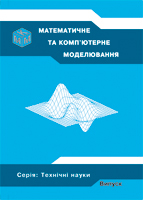ІНКРЕМЕНТНИЙ ЦИФРОВИЙ КВАЗІІДЕАЛ ІНТЕГРАТОР ЗАЯВКИ ПОПЕРЕДНЬОГО ПОТОКУ ОЦІНКИ КЕРУЮЧОЇ ІНДУКЦІЙНОЇ МАШИНИ
DOI:
https://doi.org/10.32626/2308-5916.2008-1.174-187Ключові слова:
induction machine, digital integrator, correcting errors.Анотація
The performance of the speed controlled induction machine principally depends on the accuracy of the estimated flux. The proposed method compensates the error produced by the inherent problem in the “pure” integrator and measurement error. This paper describes the problem associated with a quasi-ideal digital integrator in particularly a modern DDA-type (Digital DifferentialAnalyzer) – an incremental digital integrator (IDI). The paper essentially discusses the development of the approach to the total error correction of DDA-type IDI. It is an element for processing incremental digital input-output signals using DDA principles. The basic types of errors of the incremental digital integrator are presented and then the reasons for their appearance are examined. The differential equation dY=aYdx as an example the quantitative relation of errors is investigated. The IDI error from the analytical solution is not exceeding one increment (quant) of sub-integral function Y even during a very long interval of integration variable x. This means that the IDI becomes a practically ideal integrator. The suggested methods of correcting IDI errors can be applied in simulation, modeling, especially for dynamic systems control, etc. This method is easily applied in a DSP based induction machine control to estimate the flux.
Посилання
Sepahban, A., Podraza, G., Digital implementation of time-optimal attitude control, IEEE Trans // Automatic Control. – 1964. – Vol. 9. – No.2. – P. 164-174.
Ali-Zade P. G. An Approach to DDA integrator error correction, USSR Academy of Science // Technical Cybernetic. – 1968. – No.6. – P. 83-91.
Peter C. Maxwell, P. W. Baker, Philip G. McCrea, Incremental Computer Systems // Australian Computer Journal. – 1976. – Vol. 8. – No. 3. – P. 97-102.
Brafman H. et al. An incremental Computer // IEEE Tran., on Computers. – 1977. – Vol. C-26. – No. 11. – P. 1072-1081.
Reimar Hoefert. United States Patent 4,323,978, Apr. 6, 1982.
Fay D. Q. M. Algorithms of the digital differential analyzer genus implemented on an Intel 2920 signal processor // Software and Microsystems. – 1983. – Vol. 2. – No. 4. – P. 97-102.
Babuska, I., Miller, A. The post-processing approach in the finite element method – Part 2: The calculation of stress intensity factors. Int. J. Numer. Methods Eng. 20, 1111-1129 (1984)
Ali-Zade P. G., Radjabli K. T., Guseynov R. M. Digital integrating model for study of the anti-failure control system // Multiprocessor Computing Structures, Taganrog, USSR. – 1985. – No. 7. – P. 75-77.
Ghoshal S. K. and Rajaraman V. A Parallel Digital Differential Analyzer, in: Proceedings of Indo-US Workshop on Spectral Analysis. – New Delhi: Published by Oxford IBH, New Delhi, 1989. – P.561-75.
Dean Clark, A 2-D DDA Algorithm for fast image scaling // Dr Dobb's Journal. – April 1997. – P. 46-49.
Verschueren, A. C. ASIC layout of the real-time process thread scheduler for a multi media stream processor using a digital differential analyzer algorithm for clock cycle assignment, http: //w3. ele. tue. nl/ nl/ onderzoek/ publicatielijst_leerstoelen/ cnd/1997.
Nelson L., Monnerat P. M. A New Digital Differential Analyzer Approach for Inertial Technologies, Theses, Aerospace Engineering Dept., Carleton University, Defense Research Establishment, Ottawa (DREO), Ontario May, 2000.
Giles, M. B., Pierce, N. A.: Adjoint error correction for integral outputs, In Barth, T., Deconinck, H. (eds.) Error Estimation and Adaptive Discretization Methods in Computational Fluid Dynamics // Lecture Notes in Computational Science and Engineering. – Vol. 25. – Berlin, Heidelberg, New York: Springer, 2002. – P. 47-96.
Holtz J. and Quan J., SensorlessVector control of IM at very low speed using a nonlinear inverter model and parameter identificator // IEEE Transaction on Industry Applications. – Vol. 38. – No 4. – July/Aug 2002. – P.1087-1095.
Seyoum, M.,. Rahman F., Grantham C., Improved Flux Estimators for Induction Machines // Journal of Electrical and Electronics Engineering, Australia. – 2003. – Vol. 22. – No. 3. – P. 243-248.
Captec Ltd., Product List 2004, PCI-1241, PCI-1242, PCI-1261 – 4 (6) -Axis Pulse-type Servo Motor Control Card, (http://www.captec.co.uk).
Carry Sign and Kunle Olukotun, Stanford Un. Winter 2003 EE183 code course “Incremental Digital Integrator”, www. stanford. edu/ class/ ee183/ handouts_win2003/ lect11.pdf
Cellier F. E. Continuous System Simulation, Springer-Verlag. – New York, 2004.
Lijun Hou; Yanmin Su; Lin Chen. A DSP-based vector control of multiphase induction machine Intelligent Control and Automation, 2002 // Proceedings of the 4th World Congress on Volume 4, Issue, 2002. – P. 2831-2835. – Vol. 4.
Lee D.-J. and Wang L. (Taiwan). DSP based Control of Self-Excited Induction Generators using AC-to-DC Converters and Switched Excitation Capacitors. // From Proceeding (492) Power and Energy Systems. – 2005.
Chai, O. H.; Wong, Y. S.; Poo, A. N. A DDA Paraboiic Interpolators for Computer Numericd Control of Machine Tools // Mechatronics, Great Britain. – 1994. – Vol. 4. – No. 7. – P. 673-692.
Proakis, J. G., Manolakis, D. G. Digital Signal Processing: Principles, Algonthms and Applications // Prentice-Hall, New Jersey. – 1996, ISBX 0-13-373762.
##submission.downloads##
Опубліковано
Номер
Розділ
Ліцензія
Authors who publish with this journal agree to the following terms:- Authors retain copyright and grant the journal right of first publication with the work simultaneously licensed under a Creative Commons Attribution License that allows others to share the work with an acknowledgement of the work's authorship and initial publication in this journal.
- Authors are able to enter into separate, additional contractual arrangements for the non-exclusive distribution of the journal's published version of the work (e.g., post it to an institutional repository or publish it in a book), with an acknowledgement of its initial publication in this journal.
- Authors are permitted and encouraged to post their work online (e.g., in institutional repositories or on their website) prior to and during the submission process, as it can lead to productive exchanges, as well as earlier and greater citation of published work (See The Effect of Open Access).

